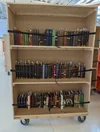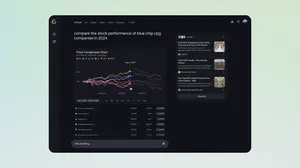How the Google Books team moved 90,000 books across a continent
Explore Google Books today, and you’ll find more than 40 million books in more than 500 languages. Through the Library Project, Google Books partners with libraries across the world to digitize physical books so they can be searched and accessed online. To do that, the books first need to be successfully transported to one of our scan centers. And sometimes, that journey is far from a simple trip.
This story starts in April 2017, when the Google Books team began discussions with the National Library of Israel. “We strongly believe in making all of our collections as open and accessible as possible, and we believe that digitization — especially out-of-copyright works — is a great way to open access,” says Yaniv Levi Korem, Head of Technical Services at the National Library of Israel. “Plus, digitization helps reduce the need to use the physical books, keeping them safe from wear and tear.”
It was determined that around 100,000 out-of-copyright books, about 45% of them in Hebrew, Yiddish and Ladino, would be scanned and incorporated into the Google Books corpus.
Books at the National Library of Israel in Jerusalem.

The problem? “Our usual methods for transporting books from the library to one of our scanning centers was not going to work,” says Fernanda Bispo, Google Books’ digitization operations manager. For other partnerships, the team relied mainly on ground transport: Carts specially designed for transporting books were loaded onto trucks that would drive from the library to one of our scanning centers.
The special carts had to be made of a material known to be neutral when in contact with books, which meant wood or metal, not plastic. The width was designed so that two carts would fit perfectly in a truck side-by-side, and the shelves are set to the maximum height capability of our scanning machines.

But transporting this treasure trove of books by land from Jerusalem was a complicated proposition, involving logistical challenges, complex international shipping regulations and numerous border crossings. From Israel, the trucks would need to take a ferry to Turkey, then drive more than 50 hours through Bulgaria, Serbia, Bosnia, Croatia, Slovenia and Austria, before arriving in Germany.
First by land, then by sea
The team considered air travel, but their transportation carts were about five inches too tall to fit in the standard air freight container. Plus, the cost would be about twice as expensive as ground shipping.
With land and air out, they set their sights on the sea. They’d ship the books from Jerusalem via sea freight to Google’s point of entry for customs clearance in Rotterdam, then by ground to Germany — a trip that would take about two to three weeks one way. While this meant they could use their special carts and stay within budget, there were still a number of challenges to address.
“When we scan a book, we transform the information within it, preserving it and making it searchable and shareable across the world,” Fernanda says. “But until we get those volumes into a scanning center, they’re incredibly fragile, vulnerable to shifts in temperature, humidity and handling. Some of these books were over 200 years old, and we needed to take great care in their transport.”
Refrigerated sea freight containers, also known as “reefers,” would do the trick, allowing them to control the temperature and humidity of the books as they made their way over sea. Fernanda would receive a notification if the temperature within the reefer exceeded 21 degrees Celsius (69.8 degrees Fahrenheit) or a humidity level above 50%.
“If the books were exposed to conditions outside of this range, they could develop mold, possibly rendering them unreadable, unscannable and unable to be reincorporated into the library’s collection,” she says. “Over the course of the project, I received a few of these notifications, but in each case, the reefer was able to correct itself and return temperatures to the appropriate range.”
Testing, testing
But let’s go back a few chapters. There was, of course, no way the team would be loading their precious cargo without some testing. They had a reefer sent to the scan center in Germany to evaluate how the unloading process would compare to their other methods of transport.
“The first issue that we had to solve was to ‘connect’ the reefer to our loading dock,” Fernanda says. “The floor of the reefer met the height of our loading dock, but it was offset by 90 degrees, meaning we could not simply back the trailer up to the dock and offload carts.”
With each cart weighing around 288 kilograms, or 635 pounds, loading and unloading had to be done with care. So, they built a “pallet bridge,” consisting of two towers of pallets that bridged the gap between the container floor and loading dock, allowing them to pull the carts directly onto the dock.
Reefers traveling across the pallet bridge to be unloaded.

Once completed, they turned the page to the next hurdle: an uneven reefer floor. The wheels of the carts were getting stuck, requiring so much force to move that it put the cart’s contents in jeopardy.
To solve this problem, they installed custom wooden flooring and added belts and bars to fix each cart into place. They also placed dunnage bags on the sides to keep the carts from touching the walls of the container, which, Fernanda says, “could lead to condensation and eventually — you guessed it — mold.”
A look at the specially designed flooring and packaging of the reefer.

Once the team was certain they could safely ship the books via sea freight, they performed a full test run. It went off without a hitch, and regular shipments began three months later. Each cart can fit about 270 books, and each reefer fits 27 carts. After 10 round-trip shipments and two years of effort, the main part of this project was successfully completed. About 90,000 books were digitized during this phase.
One of the books scanned from the National Library of Israel was “Life Songs,” a book of poems from 1884.

“The library expects to have smaller shipments of a few thousand books every few years, which could require us to revisit our shipping processes once again,” Fernanda says. “The journey of a book by sea could end up being just the beginning of our adventure.”






